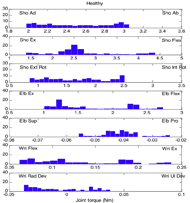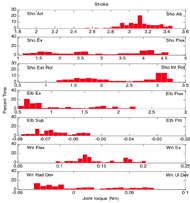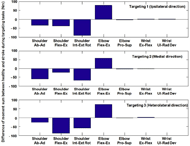KINEMATICS AND DYNAMICS ANAYSIS OF UPPER LIMBS IN STROKE PATIENTS DURING TARGETING TASKS
Kyung Kim, Ryanghee Sohn, Jeongsu Lee, Jongbae Kim, and Won-Kyung Song
National Rehabilitation Research Institute, National Rehabilitation Center, Seoul, Korea
ABSTRACT
Assistive technology for adaptation about daily living after stroke is very important to the stroke survivors. Quantitative analyzing about motion of upper limbs in patients can be utilized in design of exoskeleton robotic arm of stroke patients for the assistance of activities of daily living (ADL). In this study, we investigated the kinematics and the dynamics of upper limb motions of reaching tasks of three stroke participants and three healthy participants. The kinematics of the upper limb was acquired with a motion capture system while performing targeting tasks in three different directions. The dynamics of the upper limb was analyzed by joint moment in upper limb joints. The results indicated that the joint moments were different between stroke subjects and healthy participants. Stroke patients have an increase of the shoulder and a decrease of the elbow joint moment compared to healthy participants. These dynamics results of the motion may provide the fundamental understanding for designing assistive robots for ADL tasks of stroke survivors.
INTRODUCTION
There is important to understand the biomechanics of the activities of daily living (ADL) tasks in the people with disability. Understanding about ADL tasks can be provided for the assistive robotic device or rehabilitation training protocol as reference data. Analysis of the kinematics and dynamics in their ADL tasks is used to develop a rehabilitation robot for the assistance of ADL tasks and rehabilitative therapy of stroke patients. Accurate understanding about ADL motion of stroke patients simultaneously is remarkable issue in company with one of healthy people. Quantitative analyzing about their motion is important to develop practical upper limb assistive robot.
An anthropometric seven degree-of- freedom powered exoskeleton for the upper limb is developed (Rosen, 2005). The design of this system was based on a database defining the kinematics and dynamics of the upper limb during daily living activities, as well as joint physiological and upper limb anatomical considerations (Perry, 2006). For the improvement the design of these robotics devices, there are many challenges related to (i) kinematic compatibility, (ii) dynamic matching, (iii) lack of performance evaluation criterion, and (iv) lack of design and analysis tools [Agarwal, 2010].
In our previous study, kinematics analysis of ADL tasks between stroke patients and healthy participants was compared in 12 ADL tasks. The task completion time, trajectories, and range of motion were also determined (Kim, 2011).
In this paper, we executed the kinematics and dynamics analysis of the upper limbs targeting tasks to the eye level of the subjects. We analyzed upper limb motions of reaching tasks of three stroke participants and three healthy participants. The angle and joint moment in upper limb joints during targeting motion were determined. Our findings potentially contribute assistive robots for ADL tasks and rehabilitation therapeutic robots that equipped with customize training protocols for stroke survivors.
EXPERIMENTAL METHODS
3 healthy participants and 3 stroke patients were selected for this study. The kinematic data of the human arm of a single subject during targeting tasks were collected using the optical motion capture system (VICON system; Oxford’s Metrics, Oxford, UK) with 8 infrared cameras at a sampling frequency of 120 Hz. In this study, 3 targeting tasks of the upper limb were performed point-to-point movements in three-dimensional spaces. The end points are in eye level of each subject and ipsilateral (Targeting 1), medial (Targeting 2), and heterolateral (Targeting 3) direction according to medial-lateral directions. The dominant side (healthy participants) or the affected side (stroke patients) was examined in each participant.
The upper limb model for biomechanics at the musculoskeletal level is made by AnyBody Modeling System (AnyBody Technology Inc., Denmark). The upper limb model consists of head, trunk, and one arm part and the model contains the muscles related to the trunk and right arm. The joint moment in upper limb joints during targeting tasks was calculated by simulation of the upper limb model using AnyBody Modeling System.
RESULTS AND DISCUSSIONS
In order to investigate the moments related to the upper limb movements, we calculated the joint moment of a shoulder, an elbow, and a wrist joint for three targeting tasks. The each moment of seven movements of the three arm joints were analyzed: flexion–extension, abduction–adduction, and internal–external rotation motions of a shoulder joint; flexion– extension, pronation-supination motion of an elbow joint; and extension-flexion and ulnar- radial deviation motions of a wrist joint.
 Figure 1: Normalized time histories of the joint dynamics in seven joints of upper limbs. First line is targeting 1, second line is targeting 2, and third line is targeting 3. The mean (solid line) and standard deviation (dot line) values illustrate in the joint moments of healthy participants (blue) and stroke patients (red). (Abbreviations: Ab = Abduction, Ad = Adduction, Flex = Flexion, Ex = Extension, Int = Internal, Ext = External, Rot = Rotation, Pro = Pronation, Sup = Supination, Ul = Ulnar, Rad = Radial, Dev = Deviation.) d
Figure 1: Normalized time histories of the joint dynamics in seven joints of upper limbs. First line is targeting 1, second line is targeting 2, and third line is targeting 3. The mean (solid line) and standard deviation (dot line) values illustrate in the joint moments of healthy participants (blue) and stroke patients (red). (Abbreviations: Ab = Abduction, Ad = Adduction, Flex = Flexion, Ex = Extension, Int = Internal, Ext = External, Rot = Rotation, Pro = Pronation, Sup = Supination, Ul = Ulnar, Rad = Radial, Dev = Deviation.) dFigure 1 depicts typical normalized time histories of the seven joint moments associated with three targeting tasks between healthy participants and stroke patients. The results indicate that higher joint moments of a shoulder and an elbow joint occur during targeting tasks compared to lower moments of a wrist joint both of healthy and stroke participants. Especially, stroke patients have higher joint moments of a shoulder joint and lower joint moments of an elbow joint during targeting tasks in three directions compared to the joint moments in healthy participants.
 Figure 2: Distribution of upper limb joint moments in healthy participants during targeting 2 task (to the medial direction) d
Figure 2: Distribution of upper limb joint moments in healthy participants during targeting 2 task (to the medial direction) dStroke patients have different joint moments distributions compared to in healthy participants. To better comprehend kinematic and dynamic requirements of upper limbs for stroke patients, we calculated results of joint moment distributions of the upper limbs during targeting tasks in healthy participants and stroke patients. The joint moment distributions of targeting 2 (medical direction) in healthy and stroke participants about each joint in upper limbs are plotted in Figure 2 and 3, respectively. In histogram of joint moments, the range of moment distributions of a shoulder joint in stroke patients positioned towards positive direction in each motion of a shoulder joint; the abduction, flexion, and internal rotation motion. On the other hand, the range of moment distributions of an elbow joint in stroke patients is located on the negative direction, that is, extension motion.
To compare the difference of moment sum between healthy participants and stroke patients during targeting tasks, we calculate the integration of joint moment data. Moment sum of healthy and stroke participants during targeting tasks are calculated by integration of the absolute value of each joint moment data. Then we subtracted moment sum of stroke patients from one of healthy participants. These difference of moment sum in upper limb joints between healthy and stroke participants in targeting tasks in three directions is shown in Figure 4. Positive values of difference of moment sum show that moment sum of healthy participants are larger than one of stroke patients. In the performing of targeting tasks in three different directions, stroke patients generated larger moment sum of a shoulder joint and smaller moment sum of an elbow joint compared to healthy participants.
 Figure 3: Distribution of upper limb joint moments in stroke patients during targeting 2 task (to the medial direction) d
Figure 3: Distribution of upper limb joint moments in stroke patients during targeting 2 task (to the medial direction) dIn the gross movement of ADL tasks, we found notable differences between healthy and stroke subjects. Stroke patients tend to move gross movements by an increased adduction and internal rotation motion in a shoulder joint and a decreased flexion motion in an elbow joint. From these characteristics of stroke patients during a performing ADL tasks, stroke patients have large joint moments of a shoulder joint and small joint moments in an elbow joint compared to healthy participants.
 Figure 4: Difference of moment sum between healthy participants and stroke patients in three targeting tasks d
Figure 4: Difference of moment sum between healthy participants and stroke patients in three targeting tasks dStudying two different subjects in which a reaching task of targeting tasks indicates that dynamics of upper limb joints are different. When the stroke patients can be supported by using assistive robots for ADL tasks, the motion of a shoulder joint of stroke patients is moved by smaller magnitude of joint moment, at the same time, their elbow joint motion is utilized in assistive robots as higher moments compared to healthy participants. These quantitative motion data about targeting tasks of stroke patients plays an important role in design of assistive robots for ADL tasks and rehabilitation therapeutic robots that equipped with customize training protocols for stroke survivors. For instance, the stroke survivor's exoskeleton robotic arm could be economically designed on the basis of the above mentioned moment data.
CONCLUSION
In order to investigate the dynamic analysis of the upper limbs in stroke patients, we analyzed joint moments of upper limb joints during targeting tasks to the three directions. When stroke patients perform a targeting task, the magnitude of joint moment is higher for the motion in a shoulder and an elbow joint and smaller for the motion in a wrist joint. Comparison of the joint moments between healthy and stroke subjects during targeting tasks indicates a significant increase of a shoulder and decrease of an elbow joint moment in stroke subjects. This result suggests that assistive robots and rehabilitation robots might be utilized differently by a stroke level in each patient.
REFERENCES
Rosen, J., Perry, J. C., Manning, N., Burns, S. & Hannaford, B. (2005). The human arm kinematics and dynamics during daily activities – toward a 7 DOF upper limb powered exoskeleton. Advanced Robotics, ICAR ’05. Proceedings., 12 th International Conference on (pp. 532-539). Seattle, WA, USA.
Perry, J. C. & Rosen, J. (2006). Design of a 7 Degree-of-Freedom Upper-Limb Powered Exoskeleton. BioRob 2006-The first IEEE / RAS- EMBS International Conference on Biomedical Robotics and Biomechatronics (pp 805-810). Pisa, Tuscany, Italy.
Agarwal, P., Narayanan, M. S., Lee, L.-F., Mendel, F. & Krovi, V. N. (2010). Simulation- based design of exoskeletons using musculoskeletal analysis. Proceedings of the ASME 2010 International Design Engineering Technical Conferences & Computers and Information in Engineering Conference IDETC/CIE 2010 (pp. 1357-1364).
Kim, K., Park, D.-S., Ko, B.-W., Lee, J., Yang, S. -N., Kim, J., & Song, W.-K. (2011). Arm motion analysis of stroke patients in activities of daily living tasks: A preliminary study. Engineering in Medicine and Biology Society, EMBC, 2011 Annual International Conference of the IEEE (pp. 1287-1291).
ACKNOWLEDGEMENTS
This work was partially supported by the Research Program of NRRI [11-A-05] and the R&D Program of MKE/KEIT [10035201, ADL Support System for the Elderly and Disabled].